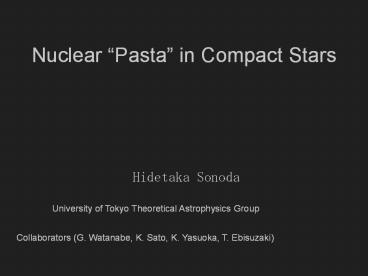Nuclear PowerPoint PPT Presentation
1 / 25
Title: Nuclear
1
Nuclear Pasta in Compact Stars
Hidetaka Sonoda
University of Tokyo Theoretical Astrophysics Group
Collaborators (G. Watanabe, K. Sato, K. Yasuoka,
T. Ebisuzaki)
2
Content
- Introduction
- Quantum Molecular Dynamics (QMD)
- Pasta Phases at zero and finite temperatures
- Neutrino opacity of Pasta phases
- Summary
3
Supernovae and Nuclear Pasta
Core-collapse Supernova Explosion
No successful simulation with realistic settings
Scenario
Bounce triggered by nuclear repulsive force
Just before bounce (just before nuclear matter
phase)
Nonspherical nuclei --- Pasta phases
Possible key element
Neutrino transport in supernova cores EOS of
dense matter
4
Neutron Stars and Nuclear Pasta
Neutron Stars
Pasta phases in the deep inside inner crust
Outer Crust
Solid of heavy nuclei
Inner crust
Transition region from nuclei to nuclear matter
Pasta Phases
Core
Liquid of nuclear matter (quark matter, hyperons)
1 km
10 km
5
What is Nuclear Pasta ?
Nonspherical nuclei in dense matter 1014g/cc
Sphere? Rod ? Slab ? Rod-like Bubbles ?
Spherical Bubbles
?Uniform Nuclear Matter
(Ravenhall et al. 1983,Hashimoto et al.1984)
Meatball Spaghetti Lasagna Anti-spaghetti Cheese ?
Pasta Phases
(K.Oyamatsu, Nucl.Phys.A561,431(1993))
6
Phase Diagram of Pasta Phases
7
Motivation
How pasta phases appear in collapsing cores ? And
in cooling neutron stars? How transition from
sphere to uniform matter ?
Pasta phases are dynamically formed as
equilibrium-state of hot dense matter in
supernovae ? as ground-state in neutron stars ?
8
Why QMD ?
Quantum Molecular Dynamics (QMD) gives us a
picture for
How nuclei are deformed into uniform nuclear
matter
QMD is suitable to answer the above question
No assumptions on nuclear shapes. Nuclear system
is treated in degrees of freedom of
nucleons. Thermal fluctuations are included.
9
Quantum Molecular Dynamics
(Chikazumi et al Phys.Rev.C 63 024602(2001))
Model Hamiltonian 1
Pauli Potential
Nuclear Force
Coulomb Energy
Kinetic Energy
(Maruyama et al Phys.Rev.C 57 655(1998))
Model Hamiltonian 2
Nucleons obey Equation of Motion of QMD
Hamiltonian is constructed to reproduce
Saturation properties of symmetric nuclear
matter Binding energy and rms radius of stable
nuclei
10
Simulation settings
Simulation Settings
2048 or 10976 nucleons in simulation box Periodic
boundary condition Proton fraction x0.3
Ground state is obtained by cooling of hot matter
Equilibrium state at finite temperature is
obtained by Nose-Hoover thermostat for MD pot.
11
Pasta at zero temperature
Cooling of hot nuclear matter (10 MeV) below 0.1
MeV
Rod
Slab
Sphere
Red Protons Blue Neutrons
Spherical Bubbles
Rod-like Bubbles
12
Sponge-like Structure
Between rod and slab, slab and rod-like
bubbles Multiply connected Sponge-like
structure appears
10976 nucleons at 0.3?0
10976 nucleons at 0.45?0
Between rod and slab
Between slab and rod bubbles
These intermediate phases at least meta-stable
13
Phase diagram at zero temperature
(a)
(S,CH)
CH,SH coexist.
SPC coexist.
S
Model 1
SP
C
SH
CH
Uniform
(C,S)
?/?0
(??)
0
0.1
0.2
0.3
0.4
0.5
0.6
0.7
0.8
0.9
(b)
SPC??
(S,CH)
SH
CH
Uniform
(C,S)
SP
C
S
Model 2
?/?0
0
0.1
0.2
0.3
0.4
0.5
0.6
0.7
0.8
0.9
(??)
SP sphere
S slab
SH spherical hole
C cylinder
( , ) intermediate
CH cylindrical hole
Sphere ?Rod ? Slab ? Rod-like bubbles ? Spherical
bubbles
?Uniform matter
14
Pasta at finite temperatures
0.393?0 (Slab nuclei at zero temperature)
T 2 MeV
T 1 MeV
T 0 MeV
Evaporated Neutrons
Slab Nuclei
Connected Slab
Increasing dripped neutrons Diffusive nuclear
surface
15
Pasta at finite temperature
T3MeV
T5MeV
T6MeV
Cannot identify nuclear surface
Phase separation disappears
Rodlike Bubble- like structure
Phase transition, Melting surface, Dripped
protons, Disappearance of phase separation
16
Phase diagram at finite temperatures
T (MeV)
SP Sphere C Cylinder S Slab CH C
bubble SH S bubble ( , ) Intermediate
Phase separation line (T6 10 MeV)
10
9
8
7
Phase separation
6
Surface line (T4 6 MeV)
5
4
(S,CH)
(C,S)
3
SP
2
SH
C
1
S
CH
?/?0
0
0.1
0.2
0.3
0.4
0.5
0.6
0.7
0.8
Thermal fluctuation increases volume fraction of
nuclei Above T 4 6 MeV, cannot identify
surface At T 6 10 MeV, Liquid-gas phase
separation
17
Summary of Phase Diagram
- Performed simulation of nuclear matter at
sub-nuclear densities with QMD - Pasta Phases are obtained by QMD
- Ground-state by cooling hot matter
- Equilibrium-state of hot matter
- How structure of nuclear matter change in the
density-temperature plane is examined
18
Neutrino Opacity of Pasta Phases
19
Motivation
Neutrino transport --- a key element for
success of supernovae
Neutrinos are trapped in collapsing phase Lepton
fraction affects EOS
How pasta phases change neutrino transport in
collapsing cores ?
20
Cross section of neutrino-Pasta
Cross section of neutrino-nucleon system coherent
scattering
Amplification factor (Static structure factor)
Neutrino-neutron cross section
Total transport cross section
?Amplification factor by structure
21
Method
- Comparison cases with and without pasta phases
- using BBP liquid drop model
- 2. Show the results obtained by QMD as realistic
model
22
Prediction by Liquid Drop Model
Amplification factor
T0 MeVYL0.3
Red with Pasta Black without Pasta
Peak at 3040 MeV Peak monotonically
decreases Below 25 MeV incoherent
Existence of Pasta phases increases peak
energy, and decreases opacity at lower energy
23
QMD results
Ye0.3, ?0.0660fm-3 (Slab at T0)
T 1 MeV
T 3 MeV
Peak is lowered by increasing temp. Transition
from slab to rod-like bubbles dramatically
changes peak energy and peak height
Phase transitions can largely change
neutrino opacity with low energy (25-30 MeV)
24
Summary of neutrino opacity
- Pasta phases decrease neutrino opacity at low
energy - Phase transitions at finite temperatures
complicate neutrino opacity
25
Summary
- Pasta phases appear with QMD simulation
- How nuclei are deformed into uniform nuclear
matter has been examined - Pasta phases decrease neutrino opacity at low
energy side - Phase transition at finite temperature complicate
neutrino opacity

